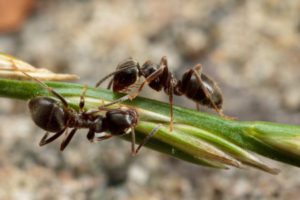HOW ANT COLONIES DEAL WITH THE THREAT OF AN INFECTIOUS DISEASE
By Zachary Ciras on October 22, 2020.
When human workers get sick with an infectious cold or flu, they (hopefully) alter their behavior and stay at home to protect other workers. When humans are faced with the spread of a pandemic, even more dramatic changes in behavior towards others would be expected.
Like us, ants are social animals, living in extended colonies with many individuals (= our cities) and in small, enclosed spaces (= our apartment buildings), and working cooperatively. What happens when a deadly pathogen finds its way into an ant colony? Do the ants act any differently? Turns out the ants know exactly what to do about a foreign invader with the potential to wipe out their colony — and they respond aggressively. We could learn a thing or two from ants!

Black Garden ants (Lasius niger)
Swiss researchers studied eleven different colonies of black garden ants (Lasius niger) that were purposely exposed to infectious fungal spores. The group, led by Nathalie Stroeymeyt, looked at the resulting behavior of both ants that worked inside the nest and worker ants that foraged outside the nest. They found that, after exposure to a pathogen, infected worker ants altered their own behavior and healthy worker ants altered their behavior towards sick ants.
AND ANTS DO IT WITHOUT THE ADVICE OF A DR. FAUCI
Living creatures, no matter whether ants or humans, develop behaviors and defenses that enable them to survive harsh conditions, including disease. Here is what researchers observed in ant colonies after a deadly fungal infection was introduced into the nest. Unless you’ve been living under a rock lately, these ant behaviors will sound eerily familiar:
- After exposure, in all of the colonies studied, the ants began to interact less with ants from other groups and more with one another. This lack of interaction helped prevent spread of the infectious spores.
- Ants protected “high-value” individuals in the colony: the queen and younger worker ants. This semi-isolation meant less exposure to the spores and therefore higher survival for these individuals. In addition, ants would groom themselves before entering the nest.
- Ants frequently groom, clean, and even “sanitize” one another to remove potentially infectious particles from each other’s bodies and to help protect the nest and young. An Austrian research study found that ants adjusted this sanitary care provided based on other ants’ level of infection.
- Ants that were left with low levels of spores on their bodies developed higher immunity. As more ants were exposed to low levels of infectious spores, the researchers noted a higher immune response in the colony. This is an ant version of the herd immunity experienced by humans after long-term disease exposure.
- Ants make use of substances with antimicrobial properties. Some ants produce toxic chemicals (formic acid) in their own bodies and can use these in grooming to sanitize and kill pathogens. Other ants collect natural materials with antimicrobial properties such as tree resin and place them in the colony to help protect the eggs and young. Ants will concoct an even more potent anti-fungal remedy by mixing their own formic acid with resin.
- Austrian researchers found that garden ants will even spray their living quarters in the nest with formic acid to kill fungi. Ant pupae that are protected inside a cocoon are resistant to this poisonous substance much as people protect themselves from household chemicals with gloves or masks.
Sick or dying ant colonies are rarely found in nature. If ant offspring become infected, workers may poison them and remove them from the nest, for the good of the colony. While we can admire the ants’ approach to disease control overall, this is one extreme step not adaptable to humans. Instead, we quarantine our offspring and buy them a computer!
[Sources: (1) StarsInsider news feed; (2) Research: Stroeymeyt, N. and A.V. Grasse, A. Crespi, D.P. Mersch, S. Cremer, L. Keller. Social network plasticity decreases disease transmission in a eusocial insect. Science 23 Nov 2018, Vol. 362, Iss. 6417, pp 941-945.]